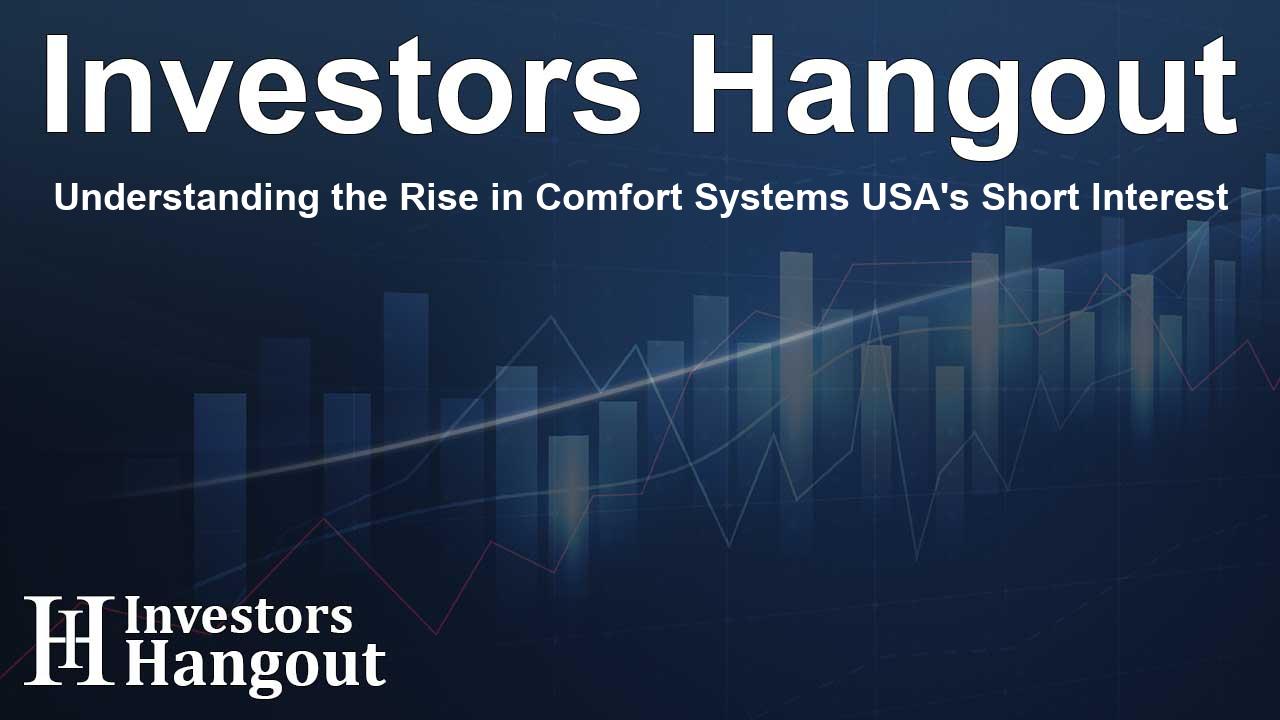Understanding the Rise in Comfort Systems USA's Short Interest

Understanding Comfort Systems USA's Short Interest
The short interest of Comfort Systems USA (NYSE: FIX) has seen a notable rise, increasing by 40.65% since the last report. This reflects growing concerns or speculation surrounding the company's stock performance. Currently, approximately 536 thousand shares are sold short, which constitutes 2.18% of the total shares available for trading. Analyzing this trend further reveals that, based on the trading volume, it would take roughly 1.35 days for traders to cover their short positions on average.
The Significance of Short Interest
Understanding short interest is crucial for investors because it indicates the sentiment surrounding a stock. It represents the total number of shares sold short but yet to be repurchased. In essence, short selling occurs when traders sell stocks they don't own, betting that the share price will decrease. Success in short selling comes when the stock price falls, allowing traders to buy back at a lower price and profit from the difference. Conversely, if the stock price increases, it triggers a loss.
Indicators of Market Sentiment
Short interest acts as a barometer of market sentiment concerning a particular stock. A rising short interest could suggest that more investors are becoming bearish, anticipating a decline in the stock's price. Conversely, a falling short interest may indicate a bullish outlook among investors, expecting price increases.
Examining Historical Trends
The trend in short selling for Comfort Systems USA indicates a growing interest in this strategy among traders. While the increase in short interest does not automatically imply that the stock's price will fall in the immediate future, it is essential for market participants to be cautious given the higher number of shares being shorted.
Graphical Representation of Short Interest
A visual representation of Comfort Systems USA's short interest over the last three months showcases its upward trajectory in the percentage of shares sold short. This graphical data provides investors with a clearer understanding of how market perception has shifted over a specific period.
Peer Comparisons: Comfort Systems USA vs. Industry
In the realm of investing, peer comparison serves as a fundamental technique for evaluating a company's performance. Here, a company is compared against others within the same industry or with similar characteristics, whether in size, age, or financial health. Such analyses often harness data from official filings or in-depth industry reports.
According to recent findings, Comfort Systems USA has a lower short interest at 2.18% compared to its peer group average of 4.48%. This notable disparity suggests that while trader interest in short positions for Comfort Systems is increasing, it still remains comparatively low against its peers.
Understanding Bullish Implications
Interestingly, rising short interest can sometimes be perceived as a bullish indicator for a stock. This might seem counterintuitive, but it sets the stage for potential short squeezes, where short-sellers are forced to buy back shares to cover their positions, driving the stock price upward.
Conclusion
As traders and investors analyze the short interest of Comfort Systems USA, it becomes clear that comprehension of such metrics plays a vital role in making informed decisions. While the rising trend in short interest indicates a shift in market sentiment, the company still enjoys relatively low short interest compared to its competitors, adding a layer of complexity to investment considerations. Staying vigilant and informed about these trends can help investors navigate the market landscape with more confidence.
Frequently Asked Questions
What does an increase in short interest indicate?
An increase in short interest may suggest that more investors are becoming bearish about a stock, anticipating a decline in its price.
How does short selling work?
Short selling involves selling shares that a trader does not own, hoping to repurchase them later at a lower price, thus profiting from the difference.
What is the current short interest for Comfort Systems USA?
The current short interest for Comfort Systems USA is approximately 2.18% of the total shares available for trading.
Can rising short interest be positive for a stock?
Yes, rising short interest can sometimes signal a potential for a short squeeze, where traders are forced to buy shares to cover their positions, potentially driving the stock price up.
How does Comfort Systems USA compare to its peers in short interest?
Comfort Systems USA has a lower short interest (2.18%) compared to its peer group average of 4.48%, suggesting it may be viewed more favorably in terms of investor sentiment.
About Investors Hangout
Investors Hangout is a leading online stock forum for financial discussion and learning, offering a wide range of free tools and resources. It draws in traders of all levels, who exchange market knowledge, investigate trading tactics, and keep an eye on industry developments in real time. Featuring financial articles, stock message boards, quotes, charts, company profiles, and live news updates. Through cooperative learning and a wealth of informational resources, it helps users from novices creating their first portfolios to experts honing their techniques. Join Investors Hangout today: https://investorshangout.com/
Disclaimer: The content of this article is solely for general informational purposes only; it does not represent legal, financial, or investment advice. Investors Hangout does not offer financial advice; the author is not a licensed financial advisor. Consult a qualified advisor before making any financial or investment decisions based on this article. The author's interpretation of publicly available data shapes the opinions presented here; as a result, they should not be taken as advice to purchase, sell, or hold any securities mentioned or any other investments. The author does not guarantee the accuracy, completeness, or timeliness of any material, providing it "as is." Information and market conditions may change; past performance is not indicative of future outcomes. If any of the material offered here is inaccurate, please contact us for corrections.